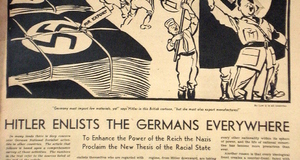Featured Article:Sociolinguistic Bias in AP Style: How News Media Deny African American Vernacular English Realities
By
2015, Vol. 7 No. 09 | pg. 1/4 | »
IN THIS ARTICLE
In Media Representations and the Global Imagination, Orgad (2012) addresses the division between content and interpretative analyses of media representations in critical theory research (36). This paper attempts a marriage of structural and cultural methods, both highlighting the bias embedded within Associated Press (AP) style and employing critical discourse analysis of journalistic productions. I argue that U.S. news media that follow AP style prioritize the realities of Standard American English (SAE) speakers; this sociolinguistic bias complements symbiotic relationships between news media and state institutions, thus buttressing normative power structures. I begin by asserting that U.S. news media productions are subjective interpretations, rather than objective representations. I claim that news media’s use of SAE familiarizes audiences with particular narratives and worldviews, affirming the lived experiences of SAE speakers, while neglecting the realities of other language communities. Next, I discuss a consequence of this sociolinguistic bias: news media that use SAE fulfill psychological needs for SAE speakers exclusively. I then offer African American Vernacular English (AAVE) as an example of a language that AP style-directed news media not only neglect, but misrepresent. I offer content analysis of the Associated Press Stylebook Online (2015) and reference Green’s (2002) African American English: A Linguistic Introduction to show how AP style delegitimizes AAVE lexicon and syntax. Furthermore, I reference a survey of 40 U.S. newspapers to examine ways in which mainstream publications ignore social issues that are pertinent to this speaking community. I conclude with discussions on the significance of AP style to other state institutions, a counterargument to my thesis rooted in Foucauldian discourse analysis, and suggestions for future research in media and cultural studies.1. The Role of Language in Relaying News Media RealitiesAs Hamilton (1997) notes in “Representing the Social: France and Frenchness in Post-War Humanist Photography,” media productions are ineludibly subjective interpretations, rather than objective representations (81-3, 98-9). He discusses post-war French photos: “Their selection, placing and framing, their connection with the content of the text, their captioning, all provide ample evidence that the meanings available to the viewer/reader on the basis of a documentary photograph are a complex representational construction” (86). Hamilton offers Doisneau’s use of les amoureux—a series of images motivated by American stereotypes of France—as an example of socially constructed documentary (96-9). The subjective nature of media representations is not limited to photography alone. The variety of choices available to journalistic publications with regards to the context, visual complementation, and other elements of style demonstrates that all news media productions—texts, photographs, television broadcasts, etc.—are ultimately subjective interpretations. One of the formal variables of a news media production is the language through which it conveys information to its audience. As Cotter (2010) notes in News Talk, there is frequently dissidence between the language that a journalistic outlet employs and that of its audience. She explains that her ethnographic approach to journalistic process legitimizes the particular languages of viewers that are absent from news media productions: “…an ethnographic approach to the study of news language…provides fundamental insights into journalistic ways of being, making evident the routines that underlie news practice…the influence of news-editorial decisions…and the relation of news values to community values” (20). By considering the language of news media through an ethnographic lens, Cotter frames it as a variable that structures journalistic productions; news media outlets reach their viewers differently depending on the language(s) they use. Accordingly, the variability of language renders news media productions interpretive, not representative. Language partly determines whether a production’s reality is accessible to the viewer; a journalistic production may affirm or disaffirm the lived experiences of the viewer, depending on whether hers is the language it uses. In Television Culture, Fiske (1987) contends that reality is always already encoded and necessarily a product of cultural codes: “If this piece of encoded reality is televised, the technical codes and representational conventions of the medium are brought to bear upon it so as to make it (a) transmittable technologically and (b) an appropriate cultural text for its audiences” (5). Cultural appropriateness relies significantly on language and its discursive properties; depending on an audience member’s particular language, a news media production may or may not relay reality. In presenting information about the world in SAE, news media affirm the realities of SAE speakers and may disaffirm the realities of non-SAE speakers. Fiske further contends that U.S. media tend to adopt “dominant,” rather than “social” realism. He defines “social realism” as a paradigm of narratives that position their audience to identify with socially marginalized classes, as opposed to “dominant realism”—a paradigm of narratives that direct viewers to identify with middle and elite class perspectives: “…most American television realism is not ‘social realism’ with its implied criticism of ‘dominant realism’. Television’s world is much more centered on the middle class, which provides its typical content and viewing position” (23). Viewers understand dominant-realistic productions easily and unproblematically from middle and elite class perspectives. Fiske offers the program Hart to Hart as an example: “Thus the Hart to Hart segment invites the viewer to ‘be’ white American, male, and middle-class. Realism achieves this position of the reading subject through its form” (25). The dominant-realistic orientation influences the language of media productions as well. Cotter explains that news media typically select prestige languages as their standard in order to reach as many viewers as possible and support the relative hierarchy among speakers from different language communities (189). Accordingly, in addition to race, class, and gender, viewers’ language determines whether a news media production affirms their lived experiences—a form of sociolinguistic bias. 2. Interaction Between News Media and the SelfNews media that relay reality through the paradigm of dominant realism reproduce normative systems of inequality because they fulfill psychological needs of viewers who identify with middle and elite class perspectives exclusively. Fiske argues that viewing television programs involves an exchange between the viewer and ideological codes. The viewer reaffirms these codes through uncritical, culturally-synchronized viewership, and in turn perceives the information that the productions transmit intelligibly: “…in making sense of the program in this way we are indulging in an ideological practice ourselves…our reward for this is the easy pleasure of recognition of the familiar and of its adequacy” (11-2). News media productions present information in accordance with ideological codes that affirm the realities of dominant groups in order to solicit viewership. Other media theorists like Orgad (42) and Macdonald, in Exploring Media Discourse (2003, 24), further show that audiences who are able to make sense of the productions they consume receive some form of psychological compensation for supporting the power structures and ideologies that news media promote. Generic cues and news compartmentalization exemplify dominant-realistic media’s simultaneous psychological support of SAE speakers and neglect of non-SAE speakers. Fiske claims that media productions offer intelligible portrayals of reality to those who understand the generic cues through which it advances narratives; they offer the “contract” of genre, which “entails a loss of freedom of desire and demand in order to achieve efficiency and properly labeled packaging” (114). For example, viewers are able to enjoy a lighthearted news segment towards the end of an evening news broadcast because they are familiar with the formal generic cues that direct them to do so (e.g., musical prompts, cliché farewells in SAE, etc.). Non-SAE speaking viewers may miss these cues, and by extension, psychological compensation for their viewership. Social psychology literature supports the characterizations of viewer-media interaction that Fisk, Orgad, and Macdonald posit. For example, Swann (2011) relies on decades of dissonance and self-consistency research to offer his theory of self-verification: “…people are motivated to maximize the extent to which their experiences confirm and reinforce their self-views” (26). For middle and elite class viewers, dominant-realistic media productions provide a consistent representation of the self that fulfills a desire for stable self-representations. Conversely, viewers for whom news media do not relay reality experience no such psychological compensation or self-verification; productions that rely on SAE to relay information reciprocate SAE speakers for their viewership, while denying these psychological rewards to non-SAE speakers. Beyond denying non-SAE speakers psychological compensation and self-verification, SAE news media fail to fulfill their desire to be recognized. Hegel (1977) identifies this desire as an inherent experience of self-conscious beings in his discussion of the lord-bondsman dialectic (111-2). He argues that self-consciousness exists when another acknowledges it, which causes the “self” to seek recognition from the “other.” Building upon Hegel’s theory and relying on Bourdieu’s concept of “habitus,” Taylor (1992) suggests that conceptions of both the “outside” world and the “inner” self depend on tacit knowledge, which the self acquires through its interaction with others in culturally-specific ways: “The importance of dialogical action in human life shows the…inadequacy of the monological subject....Much of our understanding of self, society and world is carried in practices which consist in dialogical action…language itself serves to set up spaces of common action” (36-7). Both agents engaged in face-to-face encounters and institutions with dispersive members may fulfill the role of the “other” that facilitates the dialogical process on which self-identity depends. Accordingly, news media may fulfill viewers’ desire for recognition through the language(s) they utilize. SAE news media engage SAE viewers dialogically and ignore non-SAE viewers, fulfilling only the former’s desire to be recognized. This sociolinguistic bias relegates non-SAE speakers to the position of the negligible “other.” 3. African American Vernacular English LexiconI turn now to a discussion of AAVE and its lexical reference, Webster’s New World College Dictionary, to show how news media that follow AP style neglect this spoken variety. Green presents AAVE as a structured, rule-governed variety of English that a myriad of institutions regularly neglect and misrepresent as incorrect SAE. AAVE maintains the linguistic properties that define any language: “AA[V]E is a variety that has set phonological… morphological… syntactic… semantic… and lexical patterns. So when speakers know AA[V]E, they know a system of sounds, word and sentence structure, meaning and structural organization of vocabulary” (1). I discuss two linguistic areas of AAVE that AP style delegitimizes: lexicon and syntax. With regards to the former, AP style rejects AAVE signifiers and referents; the distinct meanings that AAVE assigns to words that are homophonous with words in SAE; and the unique AAVE syntactic functions of other homophones. By undermining AAVE in these ways, news media that follow AP style promote sociolinguistic bias; they relay reality and fulfill psychological needs for SAE speakers, but not AAVE speakers. News media that follow AP style delegitimize AAVE lexically in part by restricting the language’s words and their referents. The 2015 AP stylebook maintains that use of colloquialisms and dialect should be avoided unless perhaps a word is directly and explicitly relevant to a story’s subject matter. With regards to colloquialisms, these guidelines reason that some informal words carry pejorative meaning: “Webster’s New World College Dictionary notes, for example, that ain’t is informal, a ‘dialectal or nonstandard usage’….Many still consider it illiterate and it should not be used in news stories unless needed to illustrate nonstandard speech in writing” (Associated Press, “Colloquialisms”). The stylebook rationalizes not using dialect: “Quoting dialect, unless used carefully, implies substandard or illiterate usage” (Associated Press, “Dialect”). The stylebook does not formally address usage of AAVE, so I assume that the abovementioned guidelines generally prohibit the following AAVE words: ‘sadity’, ‘dicty’, ‘tief’, ‘ting an’ ting’, and ‘yard axe’ (Green, 18-9). All of these have specific meanings (i.e., ‘sadity’ and ‘dicty’ roughly mean ‘uppity’; ‘tief’ is synonymous with ‘steal’; ‘ting an’ ting’ is a comparative adjective that nearly means ‘identical’; ‘yard axe’ refers to a preacher of little ability). News media that follow AP style engage in sociolinguistic bias, restricting use of AAVE words and the particular signified meanings they represent. AP style’s codification of non-AAVE vernacular emphasizes its bias. The following are words that the stylebook lists as acceptable to use in news stories: ‘a la carte’, ‘a la king’, ‘a la mode’, ‘al dente’, ‘al fresco’, ‘baloney’, ‘ho-hum’, and ‘hot spot’ (Associated Press, “A La Carte,” “A La King,” “A La Mode,” “Al Dente,” “Al Fresco,” “Baloney,” “Ho-Hum,” “Hot Spot”). Allowance of these reveals a double standard in the stylebook’s policy towards colloquialisms and dialect: it permits certain idioms and slang, as well as expressions borrowed from French and Italian, but interdicts utilization of AAVE lexicon. AP style also deprioritizes AAVE by ignoring particular meanings that AAVE speakers ascribe to words that are homophonous with SAE words. AAVE-SAE homophones include ‘ashy’, ‘kitchen’, ‘to get over’, ‘to call’, as well as a variety of terms for money (e.g., ‘cabbage’, ‘cheese’, ‘cream’, ‘paper’, ‘franklins’, etc.) (Green, 21-30). While ‘ashy’ refers to a color in SAE, in AAVE it describes the state of one’s skin when it has whitened and become irritated due to cold and wind. ‘Kitchen’ refers to a room for cooking in SAE and the hair at the nape of the neck in AAVE. ‘To get over’ means to overcome or surmount in SAE and to take advantage of, or to succeed by using wit with little effort in AAVE. Finally, ‘to call’ means to say in a loud voice or to demand in SAE and to attempt to do something without convincing the speaker in AAVE (e.g., “he call hisself cooking” means “he thinks he’s cooking, but he’s really not”) (Green, 21). The stylebook and the news media that follow it do not acknowledge the AAVE referents of these words, which are colloquial by default. Thus, they prioritize SAE, delegitimizing AAVE, and furthering sociolinguistic bias. When news media employ AAVE-SAE homophones in a production, AAVE speakers may realize that they are not members of its intended audience. Green notes that the dominance of SAE as the high variety of English in the U.S. requires AAVE speakers to learn lexicon in both languages (32). AAVE speakers discover that words like ‘kitchen’ and ‘ashy’ have two meanings and that SAE referents of these words typically take precedent over AAVE ones, which are usually inappropriate in media that use AP style. This bias informs the dialogical relationship between the news media outlet and AAVE-speaking viewer, who understands her primary language as illegitimate; while news media affirm the realities of SAE speakers, they deny those of AAVE speakers. Finally, AP style also delegitimizes AAVE lexicon by ignoring AAVE-SAE homophones that take on unique syntactic functions in AAVE. These include the intensifiers ‘-own-’ and ‘some’, as well as the aspect markers ‘stay’ and ‘steady’. Green explains the first intensifier’s function: -own- [on] Adj, Pronoun — self, quantifier, intensifier for reflexive pronoun… (4) I don’t need any help; I can do it myownself. Gloss: Let them clean it all by themselves (22). In AAVE, ‘some’ may resemble SAE’s ‘very’: some…to a great extent… (1) Kareem Abdul Jabar is some tall. Gloss: She can cook very well (23). In SAE, these words have syntactically distinct functions; ‘own’ operates as a verb (e.g. “I own the car”) or an adjective (e.g. “She makes her own clothes”), while ‘some’ may function as an adjective (e.g., I made some money”), a pronoun (e.g., “I’ll give you some”), or an adverb (e.g., “They change some”). Just as AP style considers some AAVE referents to be colloquial and unusable, the stylebook and Webster’s do not acknowledge the distinct syntactic functions of these intensifiers. AP style similarly disregards AAVE functions for ‘stay’ and ‘steady’. Green shows that these words operate as aspect markers: stay…(1) Live; abide in a place. (2) To frequent a place…(4) To be in some…state on most occasions… (1) I stay on New Orleans Street. He stay in the air. (5) He stay hungry. ‘Steady’ indicates that an action or process occurs continuously. This marker only precedes progressive verbs: “steady… (4) Her mouth is steady runnin’… / Gloss: She is talking nonstop” (23-4). In SAE, ‘stay’ (e.g., “I stay here”) and ‘steady’ (e.g., “His hands are steady”) have distinct verbal functions, which are commonplace in news media productions that follow AP style. These examples likewise allude to the sociolinguistic bias of the stylebook and Webster’s towards SAE lexicon.Continued on Next Page » Suggested Reading from Inquiries Journal
Inquiries Journal provides undergraduate and graduate students around the world a platform for the wide dissemination of academic work over a range of core disciplines. Representing the work of students from hundreds of institutions around the globe, Inquiries Journal's large database of academic articles is completely free. Learn more | Blog | Submit Latest in Business & Communications |


















